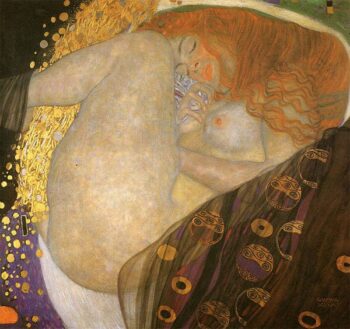
I was born with twisted legs. My feet were turned in, “pigeon-toed”; I wore casts halfway up my shins for the first six months of my life, little stone booties to correct the tibial torsion. My legs still have a tendency to turn inward, especially when I’m feeling shy. My mind still has a tendency to turn toward my legs and cringe.
*
Twelve years ago, I decided to write a cultural history of the thigh, a book that would explore changing societal ideals, a book I hoped could help me make peace with my own thighs. The book never took off for me; I set it aside to focus on other writing projects. During our latest move, I came upon two thick binders: one full of thigh research, the other full of surveys I had circulated, asking about women’s relationships with their legs. I had forgotten how many women had responded. I had forgotten how much thigh anxiety is out there in the world.
*
I used to have a happy relationship with my legs. I was a dancer and a competitive figure skater as a girl, and the second fastest runner in my class; my legs were sources of power and speed and grace. I could kick higher with my left leg, but I could lift my right leg higher in back (my signature move on the ice was to grasp my right leg behind me at the ankle and raise it up over my head). My legs shinnied me up trees, propelled me forward on bikes and in swimming pools, did the crab walk and the Hustle, and carried me regularly up five flights of stairs to my apartment. My legs were my friends, my freedom. I didn’t inspect them, couldn’t imagine dividing my body into parts like a chicken in a butcher shop, separating the dark meat from the light.
*
The word “thigh” finds its root in the Indo-European teu, meaning “to swell.” The very ampleness some of us worry about is written right into the etymology. Maybe if we remember the word holds space for abundance, we’ll be able to embrace it more fully in ourselves.
The thigh bone, or femur, is the longest bone in the human body. It finds its root in Latin—the outer thigh was known as the femar, the inner thigh the femen. The Latin word femina springs from the same root. The Romans considered thighs inherently female. Femina is also intimately connected with the Greek word phemi, meaning a woman’s ability to speak with grace.
*
I never had a negative thought about my legs until I was thirteen. We had just moved, and I was feeling uncomfortable in my new house, uncomfortable with the way puberty was breathing down my neck. I wanted to outrun it, wanted to stay in a child’s body forever.
“You have a long torso and short legs, huh?” a new friend said off-handedly one day as we stood outside our homeroom, taking off our winter boots.
“I guess so,” I said, even though I had never noticed this before. I suddenly felt grotesque, my upper body stretched to ghoulish lengths, my legs compressed into stubby little nubs. I wanted to put my boots back on, put my jacket back on, put my scarf and my hat and my gloves back on so no one would be able to see my freakishness. My friend closed her locker and walked into the classroom humming, unaware.
*
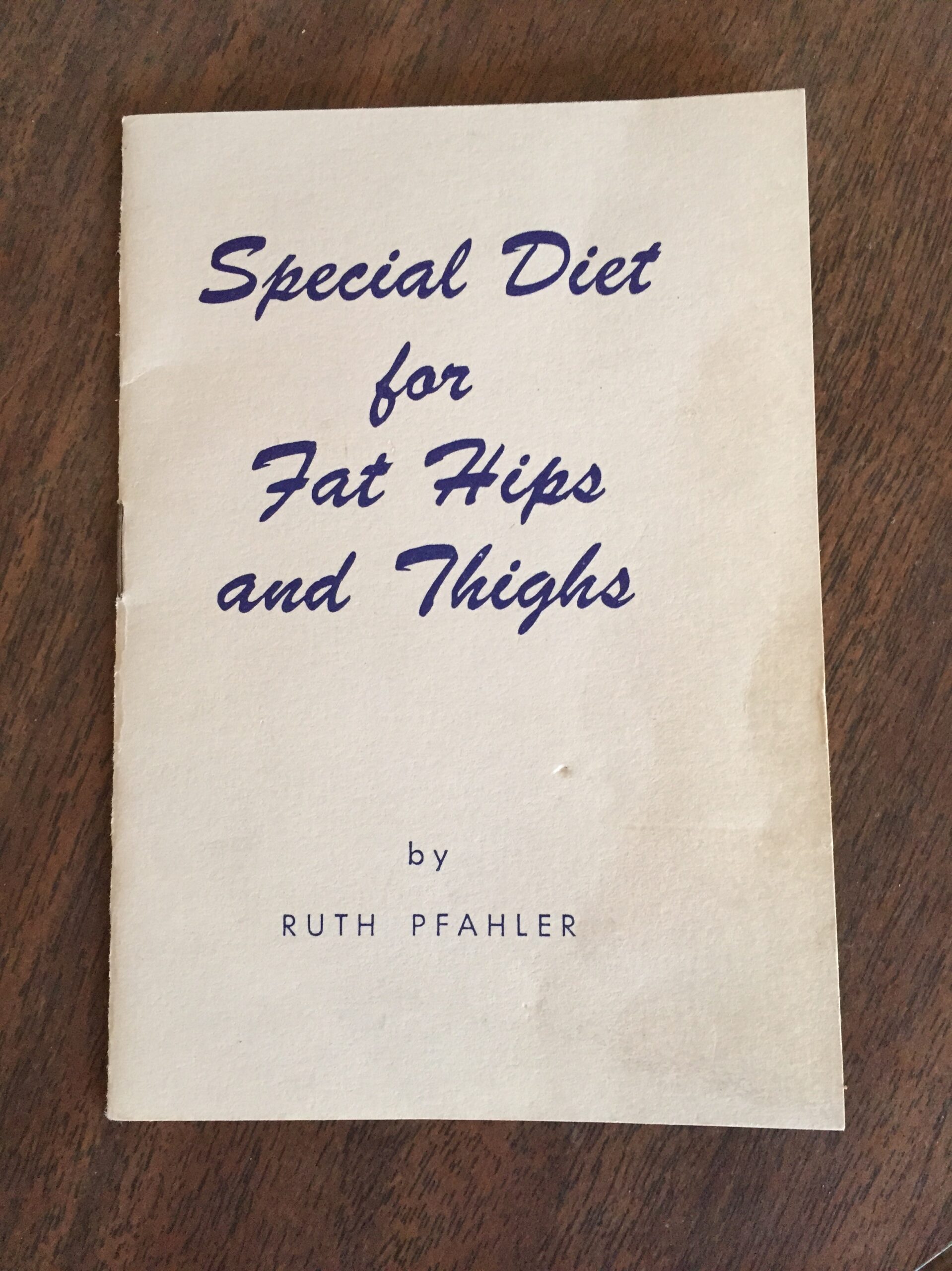 Thigh anxiety appears to be a fairly recent phenomenon. The first evidence I found of the thigh-hatred industry was a self-published diet booklet from 1953 entitled “Special Diet for Fat Hips and Thighs.” It was written by Ruth Pfahler, who owned a “reducing shop” in Decatur, Illinois. Her theory? “People with excess weight on hips and thighs consume too many sweets.” This booklet aside, it appears that widespread thigh anxiety didn’t begin to sweep the nation until the 1960s, with the advent of the miniskirt. It billowed into epidemic proportions in the 1970s, when French doctors coined the term “cellulite” in Vogue Magazine, and named it a “disfiguring” disorder. Until then, cellulite had been considered a natural part of the female body, something 90% of us have. Liposuction was introduced in France in 1977, and came to the States in 1981. The 1980s also ushered in the fitness craze (not to mention bathing suits and leotards cut high on the hip), which added a whole new dimension to thigh anxiety. Wendy Stehling’s book Thin Thighs in Thirty Days was released in 1982; it sold more than 425,000 copies in less than two months.
Thigh anxiety appears to be a fairly recent phenomenon. The first evidence I found of the thigh-hatred industry was a self-published diet booklet from 1953 entitled “Special Diet for Fat Hips and Thighs.” It was written by Ruth Pfahler, who owned a “reducing shop” in Decatur, Illinois. Her theory? “People with excess weight on hips and thighs consume too many sweets.” This booklet aside, it appears that widespread thigh anxiety didn’t begin to sweep the nation until the 1960s, with the advent of the miniskirt. It billowed into epidemic proportions in the 1970s, when French doctors coined the term “cellulite” in Vogue Magazine, and named it a “disfiguring” disorder. Until then, cellulite had been considered a natural part of the female body, something 90% of us have. Liposuction was introduced in France in 1977, and came to the States in 1981. The 1980s also ushered in the fitness craze (not to mention bathing suits and leotards cut high on the hip), which added a whole new dimension to thigh anxiety. Wendy Stehling’s book Thin Thighs in Thirty Days was released in 1982; it sold more than 425,000 copies in less than two months.
*
1982, I was stuck in the hospital with Crohn’s disease much of my freshman year of high school. My mom brought a photo from one of my skating shows to my room so I could remember being out in the world, remember being well. In it, I’m wearing a little white Spandex dress with strips of red sequins stitched into the shape of a bow tie and tuxedo lapels, a matching bowler on my head—the costume for my solo to “I Got Rhythm.”
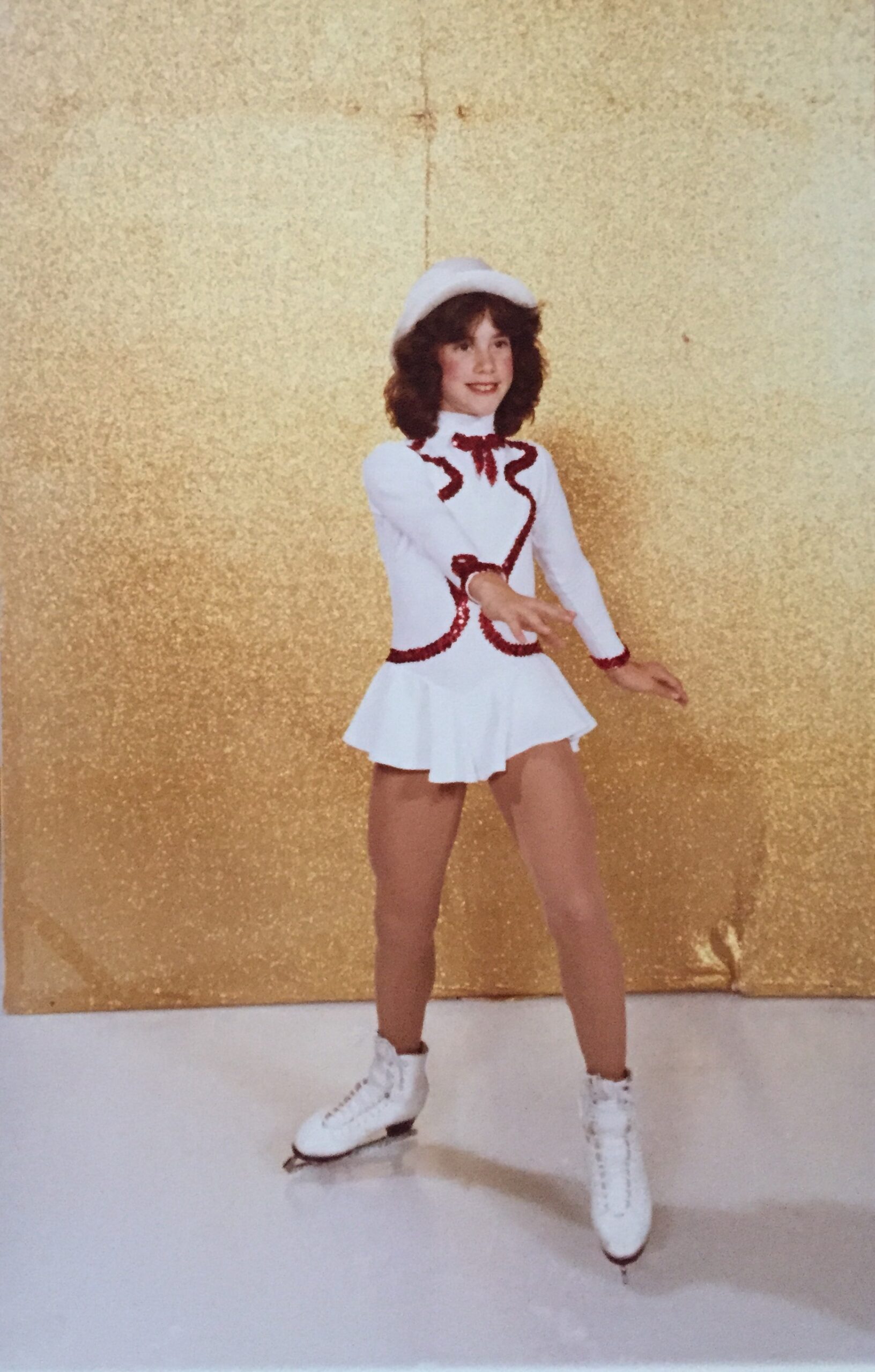 My gastroenterologist couldn’t stop starting at my thighs in the photo, one stretched before me in a shallow lunge, my toepick rooting me to the ice.
My gastroenterologist couldn’t stop starting at my thighs in the photo, one stretched before me in a shallow lunge, my toepick rooting me to the ice.
“They’re like tree trunks,” he marveled, spreading his white coated arms. “They’re each as big around as your waist.”
I was mortified. I knew I had developed muscular thighs skating, but I had never thought of them as “big” before—just strong. After his comments, they seemed elephantine, obscene, even though much of the muscle had atrophied under my hospital gown. My mom tried to convince me the doctor had been showing admiration, but I didn’t believe her. I was convinced my legs were officially weird, officially wrong.
I recently came upon this photo, and was shocked to see my legs don’t look big at all—my quads are well developed, sure, but not dramatically so. My doctor’s words had managed to influence my long-term memory of the photograph, not to mention my long-term relationship with my legs. Words like his—whether careless or intentionally hurtful—can hover over our bodies like a distorted lens; they can make it hard for us to see, to appreciate, what is truly there.
*
Survey Question #3: Has anyone ever made a comment about your thighs? Your mother, a lover, a friend? What did they say? What was your response?
–“In high school, my mom would get mad at me for buying miniskirts because ‘Your legs are so ugly, you should try to hide them.’ She was raised in Taiwan and thinks Asian women are supposed to be thin and petite.”
–“My husband once mentioned that they look like bad jello that contained some sort of bumpy fruit. I cried, he said ‘What did I say?’, and I had to leave the room and cover up.”
–“My paternal grandmother would poke at my thighs with her unlit cigarette, a chopstick, whatever was handy when I was a girl. She would tell me they were ‘fat and lumpy, like an old woman.’ I was VERY self-conscious in school because I was and am large and she always made me cry.”
–“I had a lover once who told me I had fat legs, so I told him he had a small prick, and we parted company.”
–”‘Why can’t you walk?’ kids say to me as they watch me go down the street. ‘What do you think I’m doing now?’ I want to say to them, but I don’t, so I just have to live with the fact that to them, I can’t.”
*
My own boyfriend in high school once grabbed my legs and growled “meaty thighs” like a hungry bear; he meant it affectionately, but I couldn’t help but shrink away from his hand. My boyfriend in college, who became my first husband, told me my legs were works of art, but I figured he just wasn’t looking at them closely enough.
Over one third of the women in my survey had been called “Thunder Thighs” at some point in their life. Many were still haunted by this. None of them interpreted “thunder” to mean “power.”
*
After I went into remission and my body started to accept nutrition again, I shot up several inches, leaving long, red stretch marks on my upper thighs. They looked like talon marks, as if growth had to claw its way into my flesh. Of course this made me all the more self-conscious about my legs.
“What happened to you?” a friend asked, aghast, that summer when we changed into our bathing suits. The red streaks coursed down my thighs like runnels of lava. I couldn’t answer her; all I could do was cry. She stared at me in disbelief. “Forget about it,” she finally told me. “Jeez.”
I couldn’t forget about it. For several years, I couldn’t talk about my body, any part of it, without crying. Every doctor’s visit unleashed a torrent. Every conversation about periods made me dissolve. I reached a turning point my freshman year of college when I announced, heart pounding, “I haven’t shaved my legs in ten days” to everyone in my dorm lobby. I was part of an alternative program within the university, so this was not a shocking confession—most women there were hairy-legged, hairy-pitted. It was a huge step for me, though; I was amazed that I could speak about my body—especially my legs—out loud and the world didn’t fall apart.
*
During the Victorian era, it was considered improper, if not downright scandalous, to utter “thigh” out loud in mixed company. When chicken thighs were served, they were referred to as “dark meat” (a term that of course survives to this day, a term I already used here, myself.) And of course it was considered even more improper to show one’s thighs during a time when even a peek of ankle could cause a scandal. The Italian word gamberra, meaning a woman who flaunts her thighs, is synonymous with prostitute.
*
In college, I started to feel more at home in my body than I had in years—I was in the dance studio just about every day, was finding ways to weave my body into my writing, was having lots of sex—but two different bodyworkers told me my energy only radiated from my hips up; it was as if my brain was pretending my legs didn’t exist, they said. One bodyworker spun her pendulum over my body and told me this was because of family pain from two generations back. This made some sense; my diabetic grandfather’s legs had been amputated when my mom was a young woman. Perhaps I was experiencing the opposite of phantom limb, reliving my grandfather’s karma in reverse—his brain could feel legs that weren’t there; my brain didn’t acknowledge legs that were.
*
Sometimes the brain can take this to the extreme. Some scientists believe Body Integrity Identity Disorder—a condition in which people don’t identify with at least one of their limbs and often wish to have them amputated—is caused when the brain’s mapping system can’t “see” a certain body part. Chloe Jennings, profiled in the Daily Mail, wishes to be paraplegic. “’Something in my brain tells me my legs are not supposed to work,’ she said. ‘Having any sensation in them just feels wrong.'” She wears leg braces and uses a wheel chair to approximate the paralysis she longs for. One surgeon agreed to cut her sciatic and femoral nerves, but she couldn’t afford the large cost.
I don’t have BIDD, but I did spend a few weeks in an unnecessary wheelchair when I was fifteen. As the Crohn’s disease started to wane, I pretended I was still sick—I wasn’t ready to be well, wasn’t ready to be a teenager, still wanted to be in a child’s body. I abused laxatives to keep my symptoms going, to keep myself small. One day, my mom noticed my thigh was turning in a bit at the hip, and I decided to milk this for all it was worth, limping around and complaining of pain. My doctor was worried about bone damage from long-term steroid use and told me to keep all weight off that hip until we could figure out the situation. In my wheelchair, and then my electric scooter, I became untouchable, a pure little angel. I stayed out of my body until my body couldn’t bear to be ignored anymore, until my body ached to be touched
*
Survey Question #8: Do you think about your thighs during sex? If so, how does this affect your experience?
–“I do noticed that if I’m feeling receptive, my thighs just naturally fall open… uh, like the petals of a beautiful flower unfolding. Yeah.”
–“Yes, I do. Because I have arthritis of the hips, I have a hard time opening my thighs, which means I can’t have “normal” sex, which means my love and I must get creative and work around the thighs.”
–“Occasionally, I’d be self-conscious when I got up to go to the bathroom, but only with new partners.”
–“I so prefer my thighs by candlelight.”
–“A cartoon ran in Mad Magazine in the late 80s (possibly National Lampoon). It was about how naked you could expect ‘chicks’ to get based on their religion—the reformed Jewish girl would get as naked as her cellulite would allow and was depicted in a bra and half slip.”
–“If I’m on top, I try to pull at the blankets on the bed, as if in some sort of fit of ecstasy, when I’m actually trying to cover some of my thighs and hips.”
–“Sometimes, in both good and bad ways. I think that I’m glad they’re strong, that they feel good. That’s a good thing. If I’m thinking they’re fat, unattractive, dimpled… I’m probably not having good sex. Not a bad indicator.”
*
During my first pregnancy at twenty-two, I scrutinized my body’s changes from month to month and noticed a little patch of cellulite on the back of one of my thighs, a little starburst of spider veins on the side of the other. I assumed they were temporary, that when I had the baby, things would smooth out, disappear, that my body would bounce back to its pre-pregnancy state as if nothing had happened.  I didn’t anticipate the way the cellulite would start to drift lightly down my thighs, didn’t anticipate the way other little veins would burst forth, one in the shape of a mouth, a tiny kiss left on my skin, one I couldn’t wipe away, no matter how hard I tried.
I didn’t anticipate the way the cellulite would start to drift lightly down my thighs, didn’t anticipate the way other little veins would burst forth, one in the shape of a mouth, a tiny kiss left on my skin, one I couldn’t wipe away, no matter how hard I tried.
In labor, each contraction steered clear of my belly and back and seized the fronts of my thighs, my legs clenching so hard, aching so profoundly, they felt they might shatter. Leg labor, my midwife called it, as if my baby was going to be born through my quadriceps like Dionysus, sewn into Zeus’s thigh after his pregnant mother’s death. Given my history with my legs. the fact that I ended up with leg labor—a pretty uncommon presentation—made a strange sort of sense.
*
Dionysus isn’t the only mythological figure born of a thigh.
From Griffiths’s Ramayana:
Aurva himself was also born in an extraordinary manner. A king named Kritavirya was very liberal to the Bhrigus, and through his liberality they became rich. His descendants being poor, they asked help of the Bhrigus. On this being refused them, they made an onslaught on the Brāhmans of this family, slaying all they could find, even to children in the womb. One woman concealed her unborn child in her thigh. The Kshattriyas, hearing of this, tried to slay him, but he issued from his mother’s thigh with such lustre that he blinded his persecutors. And because he was born from the thigh (uru) of his mother, he was called Aurva.
*
My family took a vacation to Jamaica when I was a baby. I consider two framed black-and-white photos from the trip amongst my most prized possessions—in one, my dad is doing the limbo; in the other, my mom is about to go under the stick,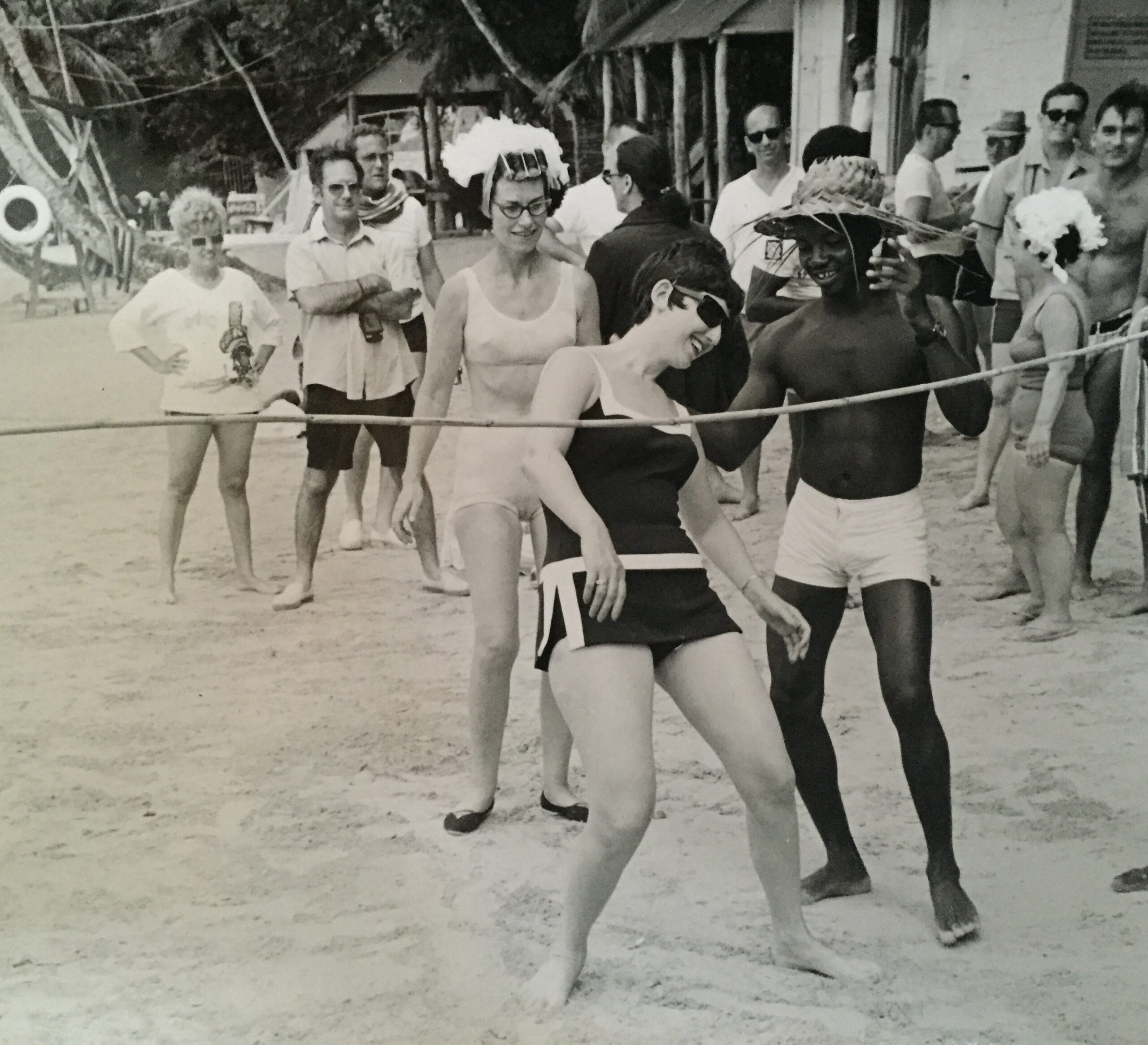 hips thrust forward in a mod skirted bathing suit. When she saw the pictures on my bookshelf, she shook her head and said, “That’s before I lost my legs.” It seemed a strange thing for a woman whose dad’s legs had been amputated to say. I felt an uncommon rush of protectiveness toward my own legs—I realized I didn’t ever want to lose them; I told myself I would never take them for granted again. My mom must have noticed the horrified expression on my face at her comment, because she said, “It was before I lost the baby weight, Gayle.” The tenderness I had been feeling toward my thighs dissolved; I started to think about the weight I was still hoping to lose.
hips thrust forward in a mod skirted bathing suit. When she saw the pictures on my bookshelf, she shook her head and said, “That’s before I lost my legs.” It seemed a strange thing for a woman whose dad’s legs had been amputated to say. I felt an uncommon rush of protectiveness toward my own legs—I realized I didn’t ever want to lose them; I told myself I would never take them for granted again. My mom must have noticed the horrified expression on my face at her comment, because she said, “It was before I lost the baby weight, Gayle.” The tenderness I had been feeling toward my thighs dissolved; I started to think about the weight I was still hoping to lose.
*
In what appears to be a highly unscientific—not to mention insulting—study done by L’eggs, 47% of women said they’d give up chocolate to have smoother legs, 25% would give up talking on the phone, and 18% would stop shopping. 31% found cellulite more troublesome than their partner’s bad behavior, 17% found it worse than dealing with their in-laws and 23% feared cellulite more than turning into their own mother. Of course, this study was released at the same time as their L’eggs Care Anti-Cellulite Legwear. So many other companies have capitalized the same consumer thigh angst—today, you can pay to have your thigh fat frozen, melted, wrapped, kneaded, or vacuumed away (results not guaranteed). You can buy creams with caffeine and retinol and seaweed and quinoa and a host of other natural and chemical ingredients, to smooth on your thighs in an attempt to smooth them out (results also not guaranteed).
*
My first husband’s best friend visited after my second baby was born when I was twenty-five, and told me I was looking good—real good, he said, eyes sweeping up and down—I just needed to work on my thighs, he said. He didn’t know thighs were the Achilles heel of my body image, didn’t know how deeply his words would cut, but still, that gave him no right to say it. My body didn’t owe him anything, not that I thought to tell him this. I didn’t think to speak up for my thighs, which were providing a soft nest for my sleeping baby. I felt a hot rush of shame instead, as if I had committed some grave moral offense by not living up to his idea of what a woman’s thighs should look like. And of course that wasn’t just his idea—he had seen that idea, that ideal, on every billboard and magazine and sitcom and porn video and commercial and and cardboard cutout of women advertising beer he had passed. So had I. I thought my thighs needed work, too.
*
A curse from the Bible: “May the Lord cause your thigh to sag and your belly to distend; may this water that induces the spell enter your body, causing the belly to distend and the thigh to sag.” (Num 5:21)
Could this have been the beginning of men judging women’s bodies? Could this be where women’s thigh anxiety began? Could it have all started out as fear of God?
*
I started wearing board shorts over my bathing suits, not wanting to inflict my thighs on the world, not wanting to hear anyone else talk about them. It didn’t matter that my cellulite was only visible in certain light; it grew in my mind more than it did on my legs—over the years, the board shorts got longer and longer. Any time I saw a woman with cellulite walk down the beach uncovered, I would admire her bravery, awed by how she didn’t care if anyone saw her body. I thought about all the tabloid covers shaming stars who dared to show cellulite on the beach. I thought about hazing rituals I had heard of where fraternity boys draw “fat circles” around bulges on sorority pledges’ thighs, marking their skin like a plastic surgeon. I thought about a Henry Rollins piece where he says something disparaging about a woman’s cellulite, implying that the woman’s partner must be disgusted by her; I thought about a review I had read of a photography exhibit, where the male critic had called photos of a woman with cellulite “grotesque.” I thought about how my mom covered up all the parts of her body she didn’t like, especially her neck, never going out in public without a scarf. Cover up your imperfections, I had learned from her. Obsess about your imperfections. Don’t let anyone know you aren’t smooth and sleek as a seal.
*
In ancient Egypt, the Goddess Hathor—also known as the Celestial Cow—had legs that held up the sky. Women would pray to have big, powerful thighs like Hathor, in both this life and beyond. One papyrus is translated as “(Hathor) shall make thy face perfect among the gods, she shall make thy thighs large among the goddesses, she shall open thine eye so that thou shalt see each day.”
*
I wrote my first book, Fruitflesh: Seeds of Inspiration for Women Who Write, to try to help myself and other women reclaim our bodies, tap into our bodies as sources of deep creativity and power. I wish I could say that after writing this book, I never felt bad about my body again, that writing this book helped me embrace every inch of myself unceasingly, unfailingly, forever. We often teach what we need to learn; sometimes we need to learn the same thing over and over again. I do have long, sweet stretches where I feel at home in my skin, where I don’t care what other people think about how I look, where I’m able to view my body with compassion and kindness and gratitude, but in the fifteen years since I wrote the book, there are still times when I backslide, times when I look at the mirror and cringe, times when I reach for the board shorts, times when I freeze if my current husband Michael touches my thigh, sure his hand is measuring it, judging it.
And he’s not. He’s not measuring; he’s not judging. He loves every part of me; he doesn’t understand why I sometimes flinch if he takes a playful peek up the back of my skirt, why I feel convinced he’s trying to block my thighs from his sight if he holds on to them in bed.
*
I would never judge another woman’s thighs the way I judge my own. I am fascinated by women’s bodies, in awe of our diversity, our integrity, our power. I know all our bodies are beautiful, that all our bodies deserve our love, no matter what size or shape or state of health or ability. I know I’m being ridiculous with my thigh preoccupation—intellectually, I know there’s nothing wrong with my body—but some reptilian part of my brain is still convinced that my legs, and my legs alone, are monstrous.
*
The Anxiety and Depression Association of America describes Body Dysmorphic Disorder as “a body-image disorder characterized by persistent and intrusive preoccupations with an imagined or slight defect in one’s appearance.
People with BDD can dislike any part of their body, although they often find fault with their hair, skin, nose, chest, or stomach. In reality, a perceived defect may be only a slight imperfection or nonexistent. But for someone with BDD, the flaw is significant and prominent, often causing severe emotional distress and difficulties in daily functioning.
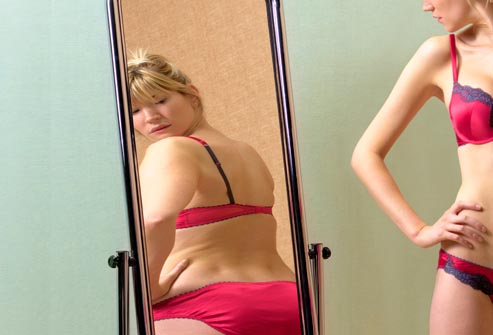 Supposedly only 1% of the population suffers from BDD, but I’m guessing a larger percentage has a mild case. We’re practically bred to have BDD in our culture. It’s never been diagnosed, but I wouldn’t be surprised if I have a touch of BDD myself; it doesn’t affect me on a daily basis, and the distress it causes is not particularly severe, but it is definitely a “persistent and intrusive preoccupation,” and I know I see my thighs as if I’m looking at them in a funhouse mirror, each flaw, each billow, magnified. If you met me, you probably wouldn’t even notice my thighs; you probably wouldn’t understand why I’d feel compelled to write an essay—to have considered writing a whole book—on the subject. I barely understand it, myself; I only know I need to face this unreasonable fixation, find a way to bring it to light.
Supposedly only 1% of the population suffers from BDD, but I’m guessing a larger percentage has a mild case. We’re practically bred to have BDD in our culture. It’s never been diagnosed, but I wouldn’t be surprised if I have a touch of BDD myself; it doesn’t affect me on a daily basis, and the distress it causes is not particularly severe, but it is definitely a “persistent and intrusive preoccupation,” and I know I see my thighs as if I’m looking at them in a funhouse mirror, each flaw, each billow, magnified. If you met me, you probably wouldn’t even notice my thighs; you probably wouldn’t understand why I’d feel compelled to write an essay—to have considered writing a whole book—on the subject. I barely understand it, myself; I only know I need to face this unreasonable fixation, find a way to bring it to light.
*
Michael and I separated for half a year in 2013. On days I didn’t have our three-year-old son, I would often forget to eat, and that, plus hiking up the hill near my new house a few times a week, not to mention a couple of bad flare-ups of Crohn’s disease, obliterated the stubborn postpartum pounds I had been wearing. Having a baby at forty-one had proven to be much rougher on my body than it had been in my twenties, and my mom’s suicide one week after I gave birth had added its own layer of kummerspeck—“grief bacon”—beneath my skin. Suddenly all of that was melting away. I would look at myself in the mirror with great curiosity, as if I was watching a science experiment, something outside of myself, my stomach growing flatter, a hollow carving itself into the sides of my thighs.
The question, “Are you starving yourself?” popped into my head, but I shoved it aside. It’s just stress from the separation, I told myself. But I let myself get used to feeling hungry, a feeling I never used to be able to abide. I told myself I was taking control of my life, but I also knew I was trying to make myself as attractive as possible for the man I had fallen in love with, the man I was going to meet in another city soon. For all my critique about the way our culture harms women’s bodies, I let myself tumble right into its trap. I would rub firming cream on my belly and the backs of my legs a couple of times a day in anticipation of our rendezvous; I would stand before the mirror and admire the growing gap between my thighs, as if that empty space somehow made me more whole, more worthy of desire.
If you look up “Thigh Gap” on Tumblr now, it leads you to a page that asks “Everything okay? If you or someone you know is struggling with an eating disorder, NEDA is here to help: call 1–800–931–2237 or chat with them online.” Everything wasn’t okay with me that summer, although I couldn’t see it at the time; in some ways, I felt better than ever, certainly more alive than I had since my mom’s death, excitement nearly levitating me out of my skin.
After this man and I finally did get together, he lay his hand on one of my legs and asked, “Is this Karen’s body?” I had no idea what he meant until he mentioned the moment in my novel Delta Girls when my character Karen’s mother tells her she’s let herself go, but Karen knows that’s really not true—the only thing she’s let go of is her mother’s intense control over her body. He didn’t say it unkindly—he had been nothing but complimentary about my body, and that moment in the book is an empowering one for Karen. Still, I felt like crying—I was thinner than I’d been in years, but all I could hear was him implying I had let myself go. If anything, I was holding on to myself too tightly, to my shrinking body, to my fantasies about what life could be like with this man, which of course only drove him away. Later, he told me it was sad that I had reduced myself to the stereotype of a scorned woman, but what I had done was even worse. I had reduced myself, period—in my tunnel vision, my body, my mind, my heart had all become slivers of their former selves. It’s taken me a long time to build them back up.
*
Thigh anxiety is definitely a first world problem, and largely a white problem. Black and Latina cultures still tend to see big, powerful legs as sexy. Missy Elliott celebrates her thick thighs in several of her songs (“No matter what your size, my big thighs’ll do my duty”, she boasts in “Pump it Up”) and Pitbull rapping “I see you baby, big thighs, small waist, cute face / I wanna please you baby,” in Ciara’s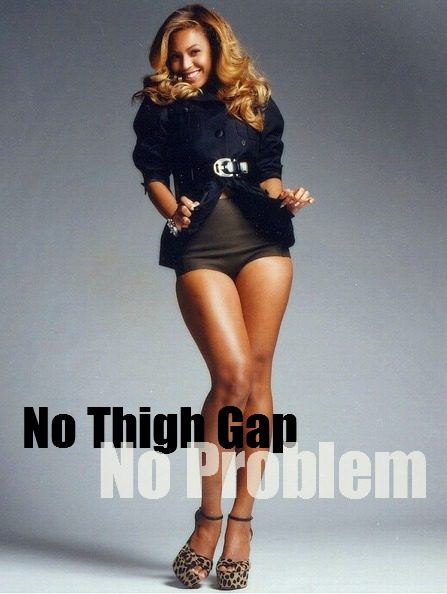 “That’s How I’m Feeling’” is worlds away from Robert Plant wailing that “big-legged women ain’t got no soul.” Even so, women of color are developing eating disorders and body image crises at an alarming rate.
“That’s How I’m Feeling’” is worlds away from Robert Plant wailing that “big-legged women ain’t got no soul.” Even so, women of color are developing eating disorders and body image crises at an alarming rate.
In Wanting to Be Her: Body Image Secrets Victoria Won’t Tell You, Michelle Graham interviews Sandra, a woman from San Juan, Puerto Rico. “I remember my pride at being complimented for my piernas gordas (fat legs) like my mother,” Sandra says. When she went off to college, Sandra was faced with a whole different beauty standard; she internalized this and “started a war against my ‘big’ butt and thighs. And it made me feel schizophrenic; too flaca in the barrio, too gorda downtown.”
The Thigh Gap Hack: The Shortcut to Slimmer, Feminine Thighs Every Woman Secretly Desires was written by a black woman, a fact that distresses Veronica Wells, who wrote the essay “Do Black Girls Want a Thigh Gap?” at Madame Noir. She ends the piece with, “For those of you still lamenting the fact that there’s not a gap between your thighs, let me leave you with this. According to my grandmother, the most important function of thick thighs is to keep your ‘fishy’ warm. And that’s important.”
*
A few months after Michael and I reconciled, I needed to have several inches of obstructed intestine removed, a complication from the Crohn’s disease. I had been unwell for awhile, unable to eat more than a couple of bites of food at a time without writhing in pain, and my weight had dropped to the point where people were expressing alarm. In the hospital, I fell beneath 100 lbs, becoming so weak, I could barely stand. My ass was gone, my legs spindles, but my thinking about my body had become so disordered, I found myself scared to put on weight as I recovered; I found myself wearing my flimsiest shoes to doctors’ appointments to keep the numbers on the scale low. As I regained strength and health, I thankfully regained my senses, as well.
I’m eating with gusto again, with pleasure. I’ve gained back all the weight I lost during the hospitalization and the separation before it, and then some. Some of the clothes that fell off of me when I was at my tiniest are snug now; I’m trying not to care about this. I’m trying to focus less on my physical appearance, more on my physical experience, grateful for the thighs that let me groove across the dance studio and walk the trail behind our house and squat down to play with my five-year-old and pull my husband in closer. The thighs that keep my fishy warm.
*
Studies have shown we spend an average of 6.5 years of our life worrying. It’s embarrassing to think about how much time I’ve wasted worrying about my thighs. Time I could have spent writing, or agitating for change, or using my legs to do something fun. And that’s been the aim of beauty standards all along, right? To get women to spend money on unnecessary products and procedures, to get us to spend time worrying about our thighs or our bellies or our wrinkles or our breasts when we could be speaking up for our rights or making art or otherwise kicking ass. That’s not a system I want to keep buying into. As Sarah Silverman says, “Mother Teresa didn’t walk around complaining about her thighs. She had shit to do.” I have shit to do, too. When I start to worry about my thighs now, I try (not always successfully) to redirect that energy in a more positive direction—channel it into a poem, or a petition, or a dance, or even just renewed appreciation for all my thighs can do. It appears that’s what therapy for Body Dysmorphic Disorder often entails, using “cognitive restructuring” to help patients recognize and shift irrational thinking patterns. If I find I’m unable to do this sustainably on my own, I’ll find someone who can help.
I see how women are helping each other online now, much in the way I had hoped to with my thigh book. A fairly new hashtag on Twitter, #thighreading, started when @princess_labia posted a photo of her thighs after she realized, “they could tell a story, the way my palms could tell a story.” In an interview with TODAY, she said “My thighs are something I’ve been insecure about my entire life. We don’t ever really see thighs that aren’t retouched and that are of average size.”
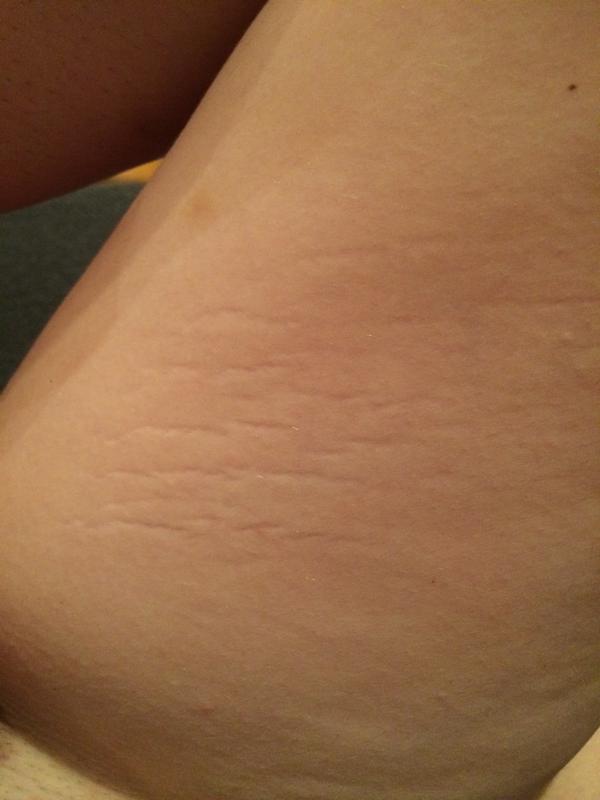 Since then, women have been posting photos of their own thighs using her hashtag, sharing their stretch marks and cellulite and scars from surgery and self-harm, with tweets like @mxurakate’s “#thighreading helps so much. I didn’t realize that so many other people have stretch marks wow now I feel like a normal human being” and @LyssaLatte’s “#thighreading I’ve always said my thighs look like raw hamburger meat cuz of cellulite. I should be easier on myself.”
Since then, women have been posting photos of their own thighs using her hashtag, sharing their stretch marks and cellulite and scars from surgery and self-harm, with tweets like @mxurakate’s “#thighreading helps so much. I didn’t realize that so many other people have stretch marks wow now I feel like a normal human being” and @LyssaLatte’s “#thighreading I’ve always said my thighs look like raw hamburger meat cuz of cellulite. I should be easier on myself.”
If #thighreading—or TV shows like Girls, or Orange is the New Black, that show women of all sizes, or even So You Think You Can Dance, where so many of the dancers have big, strong thighs like mine—had existed when I was thirteen, or even twenty-five, I doubt my thigh loathing would have become as deeply entrenched in my psyche. I would have felt much less alone, would have known it was possible to love my body even if it wasn’t smooth and svelte as Barbie’s.
*
Survey Question #9: If your thighs could talk, what would they tell you?
–“You’re kind of hard on us, don’t you think? So we don’t look like supermodel thighs, so what? Hey look at Diana Ross. Cut us some slack, sister. We never hear you complaining when you’re biking up those long hills.”
–“For crying out loud, get off your lazy ass and take us for a walk already!”
–“Don’t worry too much about us; we’re cool. We aren’t going anywhere and we will never look the way you wished we did—so give it up.”
–“Quit wearing those tight tummy trimmer underwear from Sears. We can’t breathe!”
–“Rub me.”
–“Keep on truckin’.”
–“Spread us more frequently. Do it for the team.”
–“Lighten the fuck up.”
–“LOVE US!”
*
My dear friend, poet and novelist Alma Luz Villanueva, responded to my survey twelve years ago (in answer to my question “What do your thighs like to wear?” she had written “THE OCEAN”), and recently sent a follow up: “I’ve always loved mine because they’re strong and guide me through the world,” she writes. “I trust my loyal, amiga thighs, their tender strength… QUE VIVA LAS THIGHS!!”
QUE VIVA LAS THIGHS, indeed.
*
I have an image in my head of all the women who have ever had negative thoughts about our thighs coming together; I imagine us shedding our board shorts, shedding our shame, and creating a giant kick line. Not like The Rockettes, where every thigh is the exact shape as the the one next to it—this would be a diverse kick line, with thighs of every size and age and color and ability; dimpled thighs, smooth thighs, muscled thighs, partial thighs, thighs with stretch marks and scars and veins and track marks and bruises and wrinkles and tattoos and other histories, both hard and sweet, written on our skin. Some of us can kick way up over our heads; some of us can kick knee-high, some join the line sitting or lying down, but all of us are dancing in our own way; all of us are celebrating our bodies just as they are. You can see it, can’t you, this glorious line of women? All our arms linked together? All our thighs, thundering?
***
Image Credits: Featured image, images #2 and #3 provided by author, image #4, image #5 provided by author, image #6, image #7, image #8.




